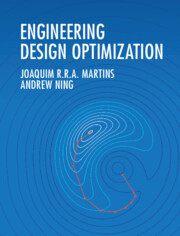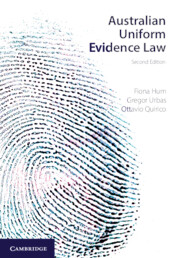Refine search
Actions for selected content:
36846 results in Cambridge Textbooks

Engineering Design Optimization
-
- Published online:
- 05 January 2022
- Print publication:
- 18 November 2021
-
- Textbook
- Export citation

Australian Uniform Evidence Law
-
- Published online:
- 05 January 2022
- Print publication:
- 11 January 2022
-
- Textbook
- Export citation

Paediatric Nursing in Australia and New Zealand
-
- Published online:
- 05 January 2022
- Print publication:
- 05 January 2022
-
- Textbook
- Export citation
Index
-
- Book:
- Paediatric Nursing in Australia and New Zealand
- Published online:
- 05 January 2022
- Print publication:
- 05 January 2022, pp 373-382
-
- Chapter
- Export citation
Acronyms and abbreviations
-
- Book:
- Paediatric Nursing in Australia and New Zealand
- Published online:
- 05 January 2022
- Print publication:
- 05 January 2022, pp xv-xviii
-
- Chapter
- Export citation
6 - Supporting families to manage child behaviour and sleep patterns, and promote optimal child development
- from Part B - Nursing infants, young children and their families
-
-
- Book:
- Paediatric Nursing in Australia and New Zealand
- Published online:
- 05 January 2022
- Print publication:
- 05 January 2022, pp 137-162
-
- Chapter
- Export citation
8 - Mental healthcare for children and adolescents
- from Part C - Nursing children and young people
-
-
- Book:
- Paediatric Nursing in Australia and New Zealand
- Published online:
- 05 January 2022
- Print publication:
- 05 January 2022, pp 193-218
-
- Chapter
- Export citation
Contributors
-
- Book:
- Paediatric Nursing in Australia and New Zealand
- Published online:
- 05 January 2022
- Print publication:
- 05 January 2022, pp x-xii
-
- Chapter
- Export citation
Contents
-
- Book:
- Paediatric Nursing in Australia and New Zealand
- Published online:
- 05 January 2022
- Print publication:
- 05 January 2022, pp v-ix
-
- Chapter
- Export citation
Acknowledgement of Country
-
- Book:
- Paediatric Nursing in Australia and New Zealand
- Published online:
- 05 January 2022
- Print publication:
- 05 January 2022, pp i-ii
-
- Chapter
- Export citation
7 - School health, health promotion and health education
- from Part C - Nursing children and young people
-
-
- Book:
- Paediatric Nursing in Australia and New Zealand
- Published online:
- 05 January 2022
- Print publication:
- 05 January 2022, pp 165-192
-
- Chapter
- Export citation
Part A - Contexts of nursing care
-
- Book:
- Paediatric Nursing in Australia and New Zealand
- Published online:
- 05 January 2022
- Print publication:
- 05 January 2022, pp 1-112
-
- Chapter
- Export citation
3 - Health services for New Zealand Māori and Aboriginal and Torres Strait Islander Australian children and young people
- from Part A - Contexts of nursing care
-
-
- Book:
- Paediatric Nursing in Australia and New Zealand
- Published online:
- 05 January 2022
- Print publication:
- 05 January 2022, pp 53-81
-
- Chapter
- Export citation
10 - The acutely ill or injured child and adolescent: Nursing assessment and interventions
- from Part C - Nursing children and young people
-
-
- Book:
- Paediatric Nursing in Australia and New Zealand
- Published online:
- 05 January 2022
- Print publication:
- 05 January 2022, pp 255-292
-
- Chapter
- Export citation
Copyright page
-
- Book:
- Paediatric Nursing in Australia and New Zealand
- Published online:
- 05 January 2022
- Print publication:
- 05 January 2022, pp iv-iv
-
- Chapter
- Export citation
11 - Recognising and responding to the sick child
- from Part C - Nursing children and young people
-
-
- Book:
- Paediatric Nursing in Australia and New Zealand
- Published online:
- 05 January 2022
- Print publication:
- 05 January 2022, pp 293-325
-
- Chapter
- Export citation
4 - Research with children and youth
- from Part A - Contexts of nursing care
-
-
- Book:
- Paediatric Nursing in Australia and New Zealand
- Published online:
- 05 January 2022
- Print publication:
- 05 January 2022, pp 82-112
-
- Chapter
- Export citation
13 - End-of-life and palliative care in paediatric care settings
- from Part C - Nursing children and young people
-
-
- Book:
- Paediatric Nursing in Australia and New Zealand
- Published online:
- 05 January 2022
- Print publication:
- 05 January 2022, pp 349-372
-
- Chapter
- Export citation
Preface
-
- Book:
- Paediatric Nursing in Australia and New Zealand
- Published online:
- 05 January 2022
- Print publication:
- 05 January 2022, pp xiii-xiii
-
- Chapter
- Export citation
5 - Working with new families throughout the transition to parenthood
- from Part B - Nursing infants, young children and their families
-
-
- Book:
- Paediatric Nursing in Australia and New Zealand
- Published online:
- 05 January 2022
- Print publication:
- 05 January 2022, pp 115-136
-
- Chapter
- Export citation
